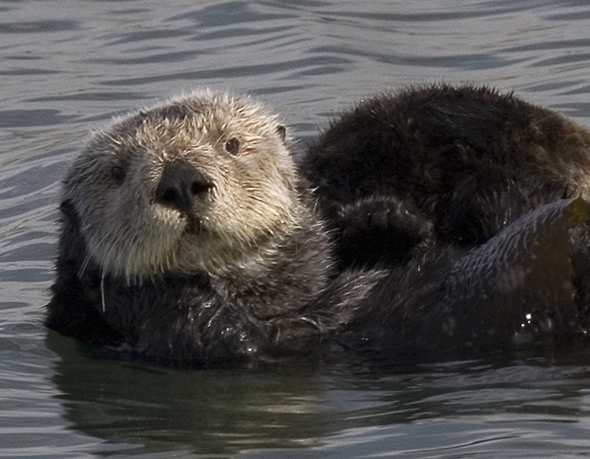 Mother sea otter with pup, photographed at Morro Rock, CA. Photo courtesy of Wikimedia Commons and “Mike” Michael L. Baird.
Mother sea otter with pup, photographed at Morro Rock, CA. Photo courtesy of Wikimedia Commons and “Mike” Michael L. Baird.
“The science points to cats,” proclaimed David Jessup (long-time opponent of TNR) and Melissa Miller in their contribution to the Spring 2011 Issue of The Wildlife Professional, in a special section called “The Impact of Free Ranging Cats” (available free via issuu.com). As I explained at the time, it wasn’t science so much as certain scientists pointing to cats as the primary cause of California sea otter mortalities associated with Toxoplasma gondii infection.
And now, a study recently published in the International Journal for Parasitology: Parasites and Wildlife goes much further in challenging the scapegoating.
“A recent series of studies on tagged sea otters challenges the hypothesis that sea otters are sentinels of a dirty ocean,” declares the U.S. Geological Survey’s Kevin Lafferty in “Sea otter health: Challenging a pet hypothesis,” and “in particular, that pet cats are the main source of exposure to Toxoplasma gondii in central California.”
“Counter to expectations, sea otters from unpopulated stretches of coastline are less healthy and more exposed to parasites than city-associated otters. Ironically, now it seems that spillover from wildlife, not pets, dominates spatial patterns of disease transmission.” [1, emphasis mine]
The grammar snob in me can’t help but point out that this is, in fact, not truly irony. More to the point, though, it shouldn’t strike researchers familiar with the subject as terribly surprising. For more than four years now, I’ve been citing published research suggesting rather strongly that wild felids probably play a greater role that domestic cats do in T. gondii-related mortalities of California sea otters.
Of course, pinning the blame on mountain lions and bobcats doesn’t attract the same media attention. (Alas, although Lafferty’s paper has been available online since June, a Google search of the terms sea otters cat feces turns up zero news stories. Had the results pointed to cats, however, the media hype would likely have been immediate and unrelenting.)
But back to Lafferty’s paper… Dissatisfied with the evidence from dead, stranded sea otters, he explains, a team of researchers “set out to compare 135 live sea otters from two ecologically similar locations that differed in human density.”
“Big Sur, that remote, uncrowded, and wild coastline that attracts adventurers, writers, and artists, was chosen as the pristine site. The impacted site was at nearby Monterey, with a busy harbor, and surrounded by intensive agriculture and nearly 50,000 pet cats, which make up for in abundance what they lack in T. gondii prevalence.” [1]
Given the widely held “pet hypothesis,” the team expected that “the city otters should be sicker than their country cousins.” [1] On the contrary, the findings showed that “the Monterey sea otters are bigger, live longer, and have a higher population growth rate,” and, “contrary to past results, infectious disease was not a particularly common source of death in the small sample of 17 tagged sea otters that were found dead during the study.” [1]
“This is not to say that domestic cats are not a source of infection for city otters,” cautions Lafferty.
“A cluster of the less pathogenic ‘domestic’ [strain of T. gondii] occurs in central Monterey Bay otters, near where this haplotype is also common in domestic cats. [2, 3] But it seems that domestic cats, by themselves, are not a substantial source of infection.” [1]
Still, such infections are, the evidence shows, significantly less likely to result in sea otter deaths. In addition, T. gondii is not the only parasite infecting these marine mammals. As the authors of a 2011 paper discovered, infection of both T. gondii and Sarcocystis neurona was more likely to lead to result in death than infection with either one alone. [4]
No doubt additional research is in the works. Unless it “points to (domestic) cats,” though, don’t expect to read about it in the pages of USA Today, or in an American Bird Conservancy press release.
Literature Cited
1. Lafferty, K.D., Sea otter health: Challenging a pet hypothesis. International Journal for Parasitology: Parasites and Wildlife, 2015. 4(3): p. 291–294. http://www.ncbi.nlm.nih.gov/pmc/articles/PMC4491668/
2. Miller, M.A., et al., Type X Toxoplasma gondii in a wild mussel and terrestrial carnivores from coastal California: New linkages between terrestrial mammals, runoff and toxoplasmosis of sea otters. International Journal for Parasitology, 2008. 38(11): p. 1319-1328. http://www.sciencedirect.com/science/article/B6T7F-4RXJYTT-2/2/32d387fa3048882d7bd91083e7566117
3. Miller, M.A., et al., An unusual genotype of Toxoplasma gondii is common in California sea otters (Enhydra lutris nereis) and is a cause of mortality. International Journal for Parasitology, 2004. 34(3): p. 275–284. http://www.sciencedirect.com/science/article/B6T7F-4BM8SYD-2/2/c7ffcf62fabfafb91e15f3b3275f4521
4. Gibson, A.K., et al., Polyparasitism Is Associated with Increased Disease Severity in Toxoplasma gondii-Infected Marine Sentinel Species. PLoS Neglected Tropical Diseases, 2011. 5(5): p. e1142. http://dx.doi.org/10.1371%2Fjournal.pntd.0001142
